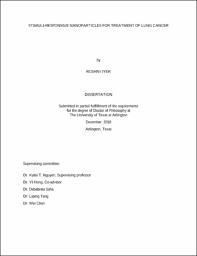
ATTENTION: The works hosted here are being migrated to a new repository that will consolidate resources, improve discoverability, and better show UTA's research impact on the global community. We will update authors as the migration progresses. Please see MavMatrix for more information.
Show simple item record
| dc.contributor.advisor | Nguyen, Kytai T | |
| dc.contributor.advisor | Hong, Yi | |
| dc.creator | Iyer, Roshni | |
| dc.date.accessioned | 2021-01-12T17:35:43Z | |
| dc.date.available | 2021-01-12T17:35:43Z | |
| dc.date.created | 2018-12 | |
| dc.date.issued | 2018-12-06 | |
| dc.date.submitted | December 2018 | |
| dc.identifier.uri | http://hdl.handle.net/10106/29679 | |
| dc.description.abstract | Despite extensive research and progress in anti-cancer therapeutics, an effective treatment for non-small cell lung cancer (NSCLC) remains elusive, resulting in poor 5-year patient survival rate. Towards this end, we have explored a therapeutic regimen to improve the effects of local concurrent chemo-radiation-therapy (CRT), by utilizing multifunctional stimuli-responsive nanoparticles (NPs) as drug carriers. We have also utilized lung cancer targeting strategies for site-specific drug delivery, mainly antibodies against the Ephrin-transmembrane receptor kinase (EphA2), that is over-expressed mainly on lung cancer cells, to promote the targeted delivery of drugs to only cancer cells, and eventually reduce the toxicity to healthy tissues. The overall goal of these NPs is to provide a triggered release of potent radiosensitizers (NU7441) upon exposure to radiation, followed by release of chemotherapeutic agents (cisplatin) in response to elevated glutathione levels in the lung cancer cells, to facilitate enhanced spatio-temporal drug release in the lung tumor environment for CRT. This design-driven research has been approached in three specific aims, each exploring the physico-chemical properties of the NPs and their in vitro and in vivo therapeutic efficacies and biodistribution; Aim 1: Cisplatin-loaded glutathione (GSH)-responsive nanoparticles (GNPs) for lung cancer chemotherapy, Aim 2: NU7441-loaded radiation (RT)-responsive NPs for lung cancer radiation therapy and Aim 3: Multifunctional dual drug-loaded, dual stimuli-responsive core-shell NPs (DSNPs) for CRT. Our results demonstrated the GSH- and radiation-responsive drug release characteristics of the NPs from Aim 1 and 2 respectively, the enhanced lung cancer cell targeting abilities of these NPs and finally their improved therapeutic efficacies compared to free drugs and untargeted NPs. Finally, a core-shell combination of these NPs observed synergistic drug release and therapeutic efficacies, concurrently with radiation therapy. These NPs could potentially be used to improve outcomes in patients with NSCLC when applying CRT to treat lung cancer. | |
| dc.format.mimetype | application/pdf | |
| dc.language.iso | en_US | |
| dc.subject | Nanoparticles | |
| dc.subject | Stimuli-responsive | |
| dc.subject | Glutathione | |
| dc.subject | Radiation | |
| dc.subject | Lung cancer | |
| dc.subject | Cisplatin | |
| dc.subject | NU7441 | |
| dc.title | Stimuli-responsive nanoparticles for treatment of lung cancer | |
| dc.type | Thesis | |
| dc.degree.department | Bioengineering | |
| dc.degree.name | Doctor of Philosophy in Biomedical Engineering | |
| dc.date.updated | 2021-01-12T17:35:44Z | |
| thesis.degree.department | Bioengineering | |
| thesis.degree.grantor | The University of Texas at Arlington | |
| thesis.degree.level | Doctoral | |
| thesis.degree.name | Doctor of Philosophy in Biomedical Engineering | |
| dc.type.material | text | |
Files in this item
- Name:
- IYER-DISSERTATION-2018.pdf
- Size:
- 2.676Mb
- Format:
- PDF
This item appears in the following Collection(s)
Show simple item record


